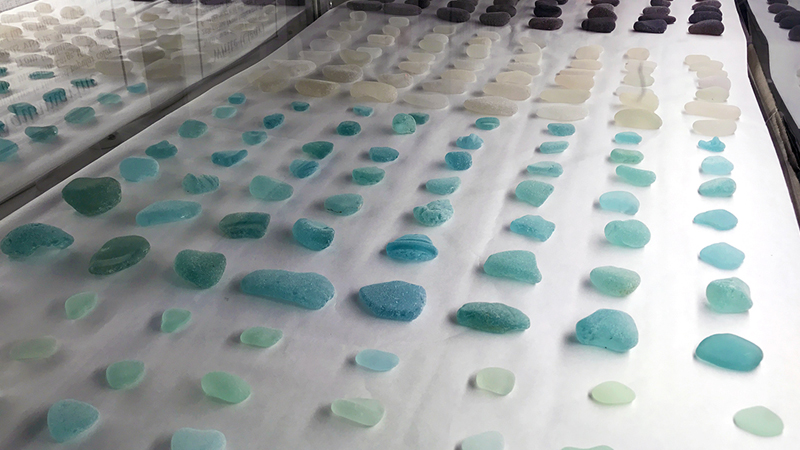
Fort Bragg sits on the majestic northern coast of California surrounded by redwood trees and the sparkling Pacific Ocean. It is famous for having one of the highest concentrations of sea glass in the world and draws visitors from all over the world to its glass beaches.
Sea glass comes from waterfront towns like Fort Bragg dumping garbage — everything from trash, appliances, glass bottles, and even cars — into the ocean. Over many years, waves crash along the shore, tumbling the glass pieces in the sand until they become smooth.
According to folklore, sea glass pieces are mermaid tears! When sailors drowned at sea, mermaid weeped and their tears would wash ashore as sea glass.
Located just south of Fort Bragg is the world’s first and only Sea Glass Museum and the largest permanent sea glass exhibit in the world. Founded in 2009, the museum has more than 150,000 pieces on display, including terracotta pieces and sea glass in a variety of shapes, sizes, and colors like rare stoppers, handle pieces, rounds and marbles — all found on Fort Bragg’s glass beaches.
After visiting Glass Beach, we stopped in the free International Sea Glass Museum to learn more about the history of sea glass, browse their extensive collection, hear stories about sea glass discoveries, and check out the small gift shop with pur sea glass jewelry, books, and other gifts.
Not All Sea Glass Is Created Equal
I didn’t know it until visiting the Sea Glass Museum, but the value of a piece of sea glass is determined by its color and size.
- Red, blue, lavender, purple, and pink sea glass is very rare because few items were ever created or stored in glass containers of those colors.
- Most red pieces of sea glass come from vehicle tail lights, lantern glass, stop lights, and Anchor Hocking beer bottles.
- Blue pieces come from apothecary items such as Milk of Magnesia, Vick’s Vapo Rub, Noxema, and Nivea, along with some prescription bottles and perfumes.
- Lavenders and pinks come from perfume bottles, art glass, and clear glass that was clarified with magnesium or selenium. Over time the sun causes the magnesium and selenium to oxidize, creating the lavender and pink colors.
- Greens, browns, and aquas come from beer bottles, soda bottles, Clorox Bleach jugs, and pretty much every other source of glass.
Sea Glass Museum History
With approximately 150,000 pieces currently on display, the Sea Glass Museum is the largest permanent sea glass exhibit in the world — and the collection is still growing!
Glass Beach Jewelry, owned and operated by Captain Cass Forrington, a retired sea captain, opened the International Sea Glass Museum in January of 2009. Thousands of people visited the museum that first year and inspired the museum to double its size in 2010. Another room was added in 2011 and a black light room was added in 2013.
Glass Beach x3
There are three glass beaches along the coastline in Fort Bragg.
After the 1906 San Francisco Earthquake also destroyed the center of town in Fort Brag, the city began ocean dumping. From 1906-1943, bulldozers simply pushed trash and everything else discarded off the cliffs into the ocean at the foot of Pine Street. The dumping was moved to a new site from 1943-1949 and then moved once more to a site that was used from 1949-1967 when the town finally stopped dumping garbage into the ocean.
The world famous Glass Beach everyone talks about is located at the third dumping site and is now part of MacKerricher State Park, which means it’s resources, including the sea glass, is protected by law and may not be removed from the site. If you had your heart set on collecting a few pieces of the stunning sea glass, don’t dismay! To the south of Glass Beach, the first two dumping sites have also become glass beaches and they have much more glass.
But why are the first two glass beaches lesser known? And why is only one glass beach actually given the official name of Glass Beach?
Not that long ago, neither of the first two glass beaches were accessible by the public — the second site required a hike and climbing precariously down the steep cliffs and the first site was only accessible by kayak. So most Fort Bragg visitors only knew of the main Glass Beach.
More recently, a paved trail was constructed along the cliffs traveling south from the Glass Beach parking lot, hugging the cliffs, and providing easy access to the first two glass beach locations.
Know Before You Go
- The International Sea Glass Museum is located at 17801 North Highway 1, Fort Bragg, California 95437 in Mendocino County.
- Admission is free.
- The Sea Glass Museum is open everyday 10:00 am to 5:00 pm.
- Pair your museum visit with a trip to nearby Glass Beach to see a beach covered in sea glass.
- A small gift shops near the entrance sells a variety of pure sea glass jewelry, books, calendars, notecards, puzzles, and other sea glass gift items.
- Did you know? Sea Glass refers to glass tumbled in salt water and beach glass refers to glass tumbled in fresh water.
- There are three glass beaches in Fort Bragg and one of them sits in MacKerricher State Park and is protected by law, which means you may not collect any sea glass at this location. You can however collect sea glass at the other two glass beaches. (Best just before low tide.)
- Visit the Sea Glass Museum before going to Glass Beach to pick up a copy of Capt. Cass’ Guide Map to the Glass Beaches of Fort Bragg.










